
An operational amplifier or op-amp is a high gain DC amplifier; the operational portion of the name derives from its original application for performing mathematical operations in analog computers. The op-amp is an analog device that is very widely used in both analog and digital design because its operating characteristics can be significantly changed by connecting different external components.
The objectives for this lab are:
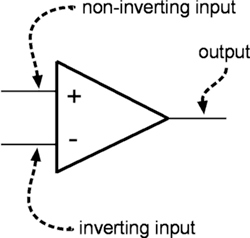
As shown in the diagram, the operational amplifier schematic symbol is a triangle and with at least two inputs and one output.
Note that the two inputs are marked and behave differently.
The inputs are not positional. Either input (inverting or non-inverting) can be the top or bottom input.
For this lab you will be using the LM741 operational
amplifier. Operational amplifier ICs are labeled
with the manufacturer's prefix code, a three digit code
indicating the type of op-amp, a letter indicating the
operating temperature range, and a suffix code indicating
the package type.
Get a type 741 op-amp IC and open the data sheet for the
741.
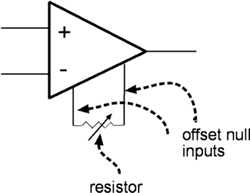
To allow for compensation of the offset voltage, some op-amps have two inputs that are called offset null inputs. If the circuit requires offset null inputs, the schematic will be as shown.
If it is necessary to compensate for the offset voltage, short the inverting and non-inverting inputs together to ground and adjust the variable resistor until the output is zero. Then reconfigure the circuit as per the schematic leaving the variable resistor in the circuit as adjusted.
Typically, we will not use the offset null inputs.
Using the data sheet, locate the offset null pins on the 741
IC.
Look at the schematic diagram of the LM471 internal circuitry on
page 4 of the data sheet and locate the offset null
inputs. Adding the offset null
fine tunes the op-amp's internal circuitry
since R1 and R2 are
probably not identical.

In addition, the op-amp IC has two inputs for power. These inputs are typically referred to as supply voltages or the rails. Typically, wiring diagrams will show the supply voltages and schematics will not show the supply voltages. The supply voltages are ALWAYS required when wiring up an op-amp even if not shown on the schematic.
These inputs power the IC and limit the behaviour of the op-amp.
It is important to note that the supply voltages are indicated as positive and negative. The positive voltage supply must be greater than the negative voltage supply.
The two most popular configurations for the supply voltages are:
Using the data sheet, locate the supply voltage pins on the 741
IC. What is the polarity of the pins? How did you determine that
from the data sheet (i.e. what notation did the data sheet use to
indicate polarity)?
If the opamp is configured using dual supply and the positive
supply is +12V, what is the voltage on the negative supply? If the
opamp is configured using single supply and the positive supply
is +12V, what is the voltage on the negative supply?
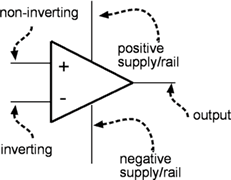
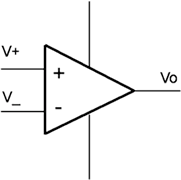
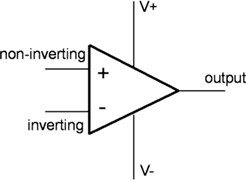
Are you using a 4 bus breadboard?
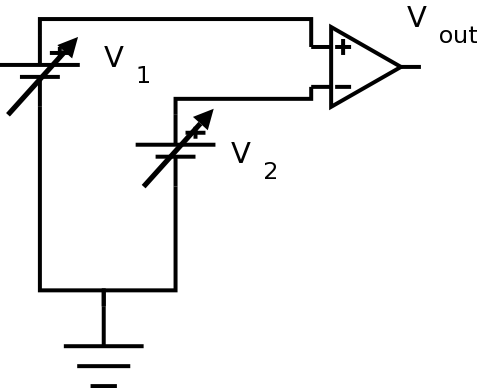
Using the LM741, construct the
open-loop comparator circuit shown.
Be sure you use a 4 bus breadboard.
Use ±12V for the supply
voltages (note the above caution about polarity).
Use the two variable dc supplies for V1 and V2.
Monitor Vout with a digital voltmeter.
![]() Never apply inputs before
establishing supply voltages.
Never apply inputs before
establishing supply voltages.
Sketch the circuit in your lab notebook. Since
you will be doing a lot of circuit variations, it is
important to get into the habit of always sketching
the circuit in your lab notebook. Always include the
supply voltages.
The term open-loop comes from control system theory; in open-loop mode the control system has no feedback. Operational amplifiers are usually used in closed-loop mode where there is feedback from the output back to the input. All of the remaining op-amp circuits you will be investigating are closed-loop, although the term closed-loop usually does not explicitly appear in the name of the circuit.
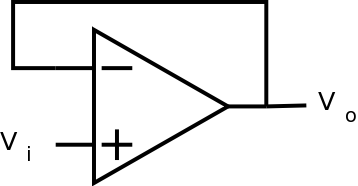
The voltage follower (or buffer) is a very simple circuit where the output should "follow" the input. In other words, Vout should equal Vin.
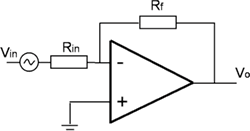
An inverting amplifier circuit produces an amplified output signal that is 180° out of phase with the input signal.
Using an LM741, construct the closed-loop inverting amplifier circuit shown to the left. Use ±12V for the supply voltages. Use a feedback resistor, Rf, of 10 kOhms and an input resistor, Rin, of 1 kOhms. When you sketch the circuit in your lab notebook, note the feedback and input resistor values.




Wilfrid Laurier University
© 2019 Wilfrid Laurier University